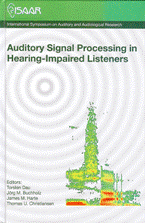Insights into optimal phonemic compression from a computational model of the auditory periphery
Abstract
Phonemic compression schemes for hearing aids have thus far been developed and evaluated based on perceptual criteria such as speech intelligibility, sound comfort, and loudness equalization. Finding compression parameters that optimize all of these perceptual metrics has proved difficult. The goal of this study was to nd optimal single-band gain adjustments based on the response of auditory-nerve bers to speech. Sentences from the TIMIT database were processed by either the NAL-R or the DSL ampli cation scheme, and deviations from these linear prescriptions were obtained by adjusting the overall gain from 40 dB below to 40 dB above the prescribed gains in 5 dB steps. Neural responses were obtained using the cat auditory-periphery model of Zilany and Bruce (2006, 2007). Sentences were analyzed on a phone by phone basis to nd the gain adjustment that minimized the difference in neural response to the amplified phone in the impaired model and the unampli ed phone in the normal model. The optimal gain adjustments were found to depend on whether the error metric included the spike timing information of the neural responses (i.e., a time resolution of several microseconds) or just the mean ring rates (i.e., a time resolution of several milliseconds). To optimize the mean ring rates, gain adjustments on the order of +10 dB were required above the prescribed linear gains in general. In contrast, gain adjustments on the order of 10 dB or more below the prescribed linear gains tended to optimize the responses including spike timing information. Wide dynamic range compression appears to be more bene cial in optimizing the spike timing information than the mean rate information. These results motivate the development of novel nonlinear amplification schemes that simultaneously optimize both spike-timing and mean-rate neural representations.
References
Byrne, D., Dillon, H., Ching, T., Katsch, R. and Keidser, G. (2001). “The NAL-NL1 procedure for fitting non-linear hearing aids: Characteristics and comparisons with other procedures,” J. Am. Acad. Audiol., 12, 37–51.
Carney, L. H. (1994). “Spatiotemporal encoding of sound level: models for normal encoding and recruitment of loudness,” Hear. Res., 76, 31–44.
Dillon, H. (2001). Hearing Aids. Thieme Medical Publishers (New York).
Heinz, M. G. and Young, E. D. (2004). “Response growth with sound level in auditory-nerve fibers after noise-induced hearing loss,” J. Neurophysiol., 91, 784–795.
Liberman, M. C. (1978). “Auditory nerve response from cats raised in a low noise chamber,” J. Acoust. Soc. Am., 63, 442–455.
Miller, R. L., Schilling, J. R., Franck, K. R. and Young, E. D. (1997). “Effects of acoustic trauma on the representation of the vowel /ε/ in cat auditory nerve fibers,” J. Acoust. Soc. Am., 101, 3602–3616.
Moore, B. C. J. (2004). “Testing the concept of softness imperception: Loudness near threshold for hearing-impaired ears,” J. Acoust. Soc. Am., 115, 3103–3111.
Scollie, S., Seewald, R., Cornelisse, L., Moodie, S., Bagatto, M., Laurnagaray, D., Beaulac, S. and Pumford, J. (2005). “The desired sensation level multistage input/output algorithm,” Trends in Ampli cation, 9, 159–197.
Wiener, F. M. and Ross, D. A. (1946). “The pressure distribution in the auditory canal in a progressive sound eld,” J. Acoust. Soc. Am., 18, 401–408.
Zilany, M. S. A. (2007). Modeling the Neural Representation of Speech in Normal Hearing and Hearing Impaired Listeners. Ph.D. Thesis, McMaster University, Hamilton, ON.
Zilany, M. S. A. and Bruce, I. C. (2006). “Modeling auditory-nerve responses for high sound pressure levels in the normal and impaired auditory periphery,” J. Acoust. Soc. Am., 120, 1446–1466.
Zilany, M. S. A. and Bruce, I. C. (2007). “Representation of the vowel /ε/ in normal and impaired auditory nerve bers: Model predictions of responses in cats,” J. Acoust. Soc. Am., 122, 402–417.
Additional Files
Published
How to Cite
Issue
Section
License
Authors who publish with this journal agree to the following terms:
a. Authors retain copyright* and grant the journal right of first publication with the work simultaneously licensed under a Creative Commons Attribution License that allows others to share the work with an acknowledgement of the work's authorship and initial publication in this journal.
b. Authors are able to enter into separate, additional contractual arrangements for the non-exclusive distribution of the journal's published version of the work (e.g., post it to an institutional repository or publish it in a book), with an acknowledgement of its initial publication in this journal.
c. Authors are permitted and encouraged to post their work online (e.g., in institutional repositories or on their website) prior to and during the submission process, as it can lead to productive exchanges, as well as earlier and greater citation of published work (See The Effect of Open Access).
*From the 2017 issue onward. The Danavox Jubilee Foundation owns the copyright of all articles published in the 1969-2015 issues. However, authors are still allowed to share the work with an acknowledgement of the work's authorship and initial publication in this journal.


